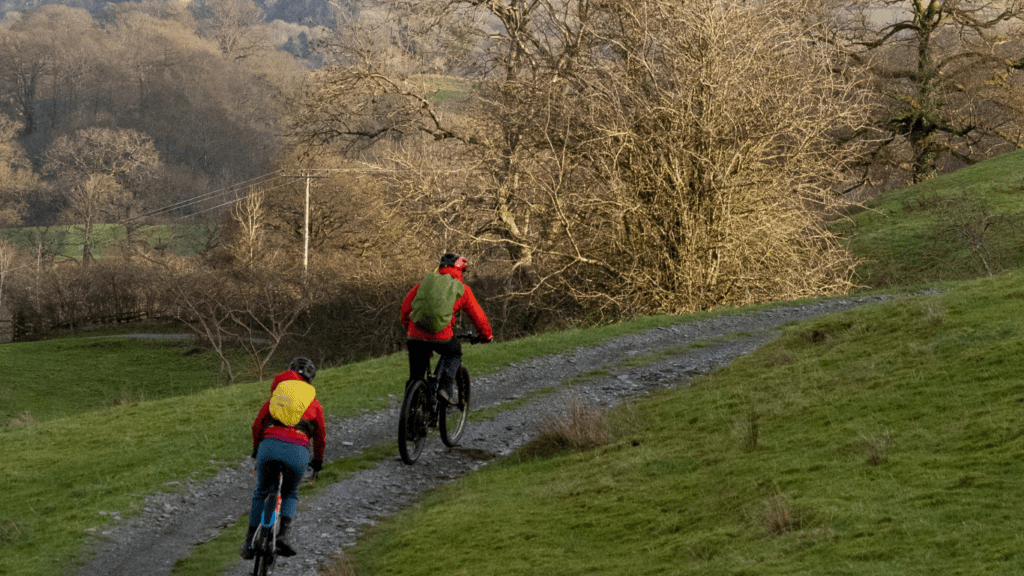Understanding Gravel Biking
Gravel biking opens a new realm of cycling possibilities. Its versatility offers a unique blend of road and mountain biking experiences.
Origins and History
Gravel biking emerged in the early 2000s in the United States. Riders sought new adventures beyond paved roads. Events like the Dirty Kanza, now known as Unbound Gravel, popularized this form of cycling.
These races showcased the thrill and challenge of riding on mixed terrain. As more cyclists joined, bike manufacturers began producing specific gravel bikes, further fueling the sport’s growth.
What Makes It Unique?
- Gravel biking stands out due to its adaptability. Unlike road bikes, gravel bikes handle a variety of surfaces, including dirt, gravel, and uneven trails.
- They feature wider tires, usually ranging from 35mm to 50mm, providing better traction and comfort on rough terrain.
- Gravel bikes also have more relaxed geometries, ensuring stability and comfort on long rides.
- They often include additional mounting points for carrying gear, making them ideal for bikepacking and extended tours.
- This combination of features allows riders to explore diverse landscapes with fewer limitations.
Equipment and Gear
Gravel-specific equipment enhances the riding experience. A gravel bike typically includes a durable frame made of aluminum, steel, titanium, or carbon fiber.
Disc brakes offer reliable stopping power in various conditions. Tubeless tires reduce the risk of flats and provide a smoother ride. Items like gravel-specific apparel, multi-tools, and hydration systems ensure riders are prepared for diverse conditions.
Community and Events
The gravel biking community is inclusive and welcoming. Events range from local group rides to international races. Notable events like Unbound Gravel, Gravel Worlds, and Grinduro attract cyclists worldwide.
These gatherings emphasize camaraderie and adventure over competition, promoting a supportive environment for riders of all levels.
Gravel biking continues to evolve, drawing more enthusiasts every year. Its unique combination of challenge, adventure, and community makes it a standout in the cycling world.
Essential Gear for Gravel Biking
Gravel biking’s unique demands call for specialized gear. Selecting the right equipment enhances the experience and ensures safety on varied terrain.
Choosing the Right Bike
Gravel bikes combine features of road and mountain bikes to handle mixed surfaces. Look for models with wider tires and relaxed geometry.
These attributes offer stability and comfort on rough paths. Brands like Specialized Diverge and Cannondale Topstone stand out in this category.
Opt for a durable frame material, such as aluminum or carbon fiber, which balances weight and resilience. Disc brakes are essential as they provide reliable stopping power in all conditions.
Must-Have Accessories
Accessories boost both convenience and safety when gravel biking. A few essentials include:
- Tubeless Tires: Reduce flats and allow lower tire pressure for better traction.
- Bikepacking Bags: Secure storage for long rides. Brands like Revelate and Apidura offer reliable options.
- Cycling Computer: Tracks essential data like speed and distance. Garmin and Wahoo provide top models.
- Helmet: Never compromise on safety. MIPS technology helmets offer enhanced protection.
- Hydration System: Stay hydrated with options like frame-mounted water bottles or hydration packs.
- Multi-Tool: Essential for on-the-go repairs. Look for compact, versatile tools.
Proper gear ensures you maximize comfort and performance while gravel biking.
Skills and Techniques for Gravel Biking

Gravel biking offers a unique challenge that combines road and off-road cycling. Acquiring the right skills and techniques ensures a safe, enjoyable ride.
Navigating Different Terrains
Gravel routes span a variety of surfaces like dirt, gravel, and singletrack. To navigate these, I recommend adjusting tire pressure based on the terrain. Lower pressure (30-50 psi) provides more traction on loose gravel.
For descents, keep your weight low and back to maintain balance. On climbs, shift to a lower gear early, and stay seated to maximize traction.
When riding through sand or mud, maintain a steady speed and avoid sudden movements to prevent skidding.
Building Endurance and Speed
Gravel rides often cover long distances. To build endurance, I integrate interval training into my routine—alternating high intensity with recovery periods. Gradually increasing ride durations also enhances stamina.
For speed, focus on pedaling efficiency. I use a cadence of 80-100 rpm for optimal power output. Strengthening core muscles through exercises like planks and leg raises improves overall stability and biking performance.
Engaging in regular cross-training such as running or swimming boosts cardiovascular fitness, contributing to better speed on the bike.
Mastering these skills and techniques elevates the gravel biking experience, ensuring both safety and enjoyment on diverse terrains.
Benefits of Gravel Biking
Gravel biking offers numerous benefits, blending adventure and fitness. Its popularity stems from various advantages that cater to a wide range of cyclists.
Health and Fitness Advantages
Gravel biking provides an excellent cardiovascular workout. By riding on mixed terrains, cyclists enhance their endurance and stamina. Studies show consistent cycling improves heart health, reducing risks of cardiovascular diseases.
Gravel biking also builds strength. Navigating uneven surfaces engages core muscles, legs, and upper body, promoting overall muscular fitness. Strenuous climbs and varied terrains boost calorie burning and aid weight management.
The activity’s outdoor nature enhances mental well-being. Exposure to nature reduces stress and increases mental clarity.
Engaging in regular gravel biking can alleviate symptoms of depression and anxiety, creating a holistic fitness experience.
Environmental Impact
Gravel biking has a lower environmental impact compared to motorized sports. It’s a sustainable mode of transportation, relying on human power and reducing carbon emissions.
In regions where this type of cycling is popular, local ecosystems benefit from environmental consciousness among cyclists.
Cyclists often promote conservation efforts. The gravel biking community advocates for the protection of natural trails and supports initiatives that maintain the integrity of biking environments.
By choosing gravel biking, individuals contribute to environmental preservation and sustainable tourism.
Gravel bikes, built to last, reduce waste. Durable frames and components extend the bike’s lifecycle, minimizing the need for frequent replacements.
Additionally, many gravel bikers opt for eco-friendly gear and accessories, further lowering their carbon footprint.

 I'm Daniel Leverette, and I’m excited to be part of the incredible team at Cycle Smooth Ride Long. Cycling has always been a passion of mine, and now, I get to share that passion with you by bringing expert insights, reviews, and tips to help you elevate your ride.
At Cycle Smooth Ride Long, we believe that every cyclist deserves the best experience, whether you’re hitting the pavement for a casual ride or gearing up for an intense training session. My goal is to ensure that you have the knowledge and tools you need to enjoy every mile, from choosing the right gear to optimizing your nutrition and fitness.
I'm Daniel Leverette, and I’m excited to be part of the incredible team at Cycle Smooth Ride Long. Cycling has always been a passion of mine, and now, I get to share that passion with you by bringing expert insights, reviews, and tips to help you elevate your ride.
At Cycle Smooth Ride Long, we believe that every cyclist deserves the best experience, whether you’re hitting the pavement for a casual ride or gearing up for an intense training session. My goal is to ensure that you have the knowledge and tools you need to enjoy every mile, from choosing the right gear to optimizing your nutrition and fitness.
